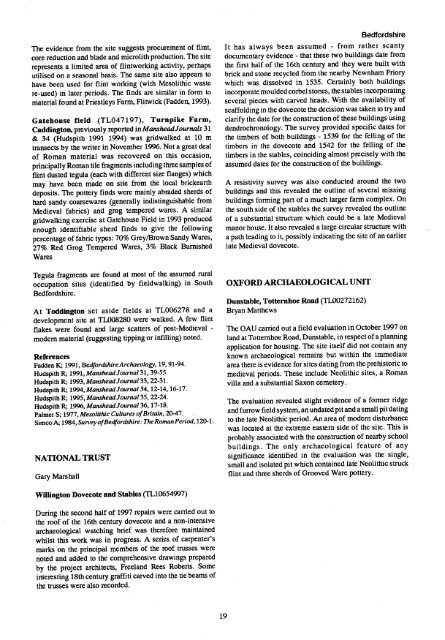CBA SMA\SMA 1998.PDF - Council for British Archaeology
CBA SMA\SMA 1998.PDF - Council for British Archaeology
CBA SMA\SMA 1998.PDF - Council for British Archaeology
Create successful ePaper yourself
Turn your PDF publications into a flip-book with our unique Google optimized e-Paper software.
The evidence from the site suggests procurement of flint,<br />
core reduction and blade and microlith production. The site<br />
represents a limited area of flintworking activity, perhaps<br />
utilised on a seasonal basis. The same site also appears to<br />
have been used <strong>for</strong> flint worlcing (with Mesolithic waste<br />
re-used) in later periods. The finds are similar in <strong>for</strong>m to<br />
material found at Priestleys Farm, Flitwick (Fadden, 1993).<br />
Gatehouse field (TL047197), Turnpike Farm,<br />
Caddington, previously reported in MansheadJournals 31<br />
& 34 (Hudspith 1991 1994) was gridwalked at 10 m<br />
transects by the writer in November 1996. Not a great deal<br />
of Roman material was recovered on this occasion,<br />
principally Roman tile fragments including three samples of<br />
flint dusted tegula (each with different size flanges) which<br />
may have been made on site from the local brickearth<br />
deposits. The pottery finds were mainly abraded sherds of<br />
hard sandy coarsewares (generally indistinguishable from<br />
Medieval fabrics) and grog tempered wares. A similar<br />
gridwalldng exercise at Gatehouse Field in 1993 produced<br />
enough identifiable sherd finds to give the following<br />
percentage of fabric types: 70% Grey/Brown Sandy Wares,<br />
27% Red Grog Tempered Wares, 3% Black Burnished<br />
Wares<br />
Tegula fragments are found at most of the assumed rural<br />
occupation sites (identified by fieldwalking) in South<br />
Bed<strong>for</strong>dshire.<br />
At Toddington set aside fields at TL006278 and a<br />
development site at TL008280 were walked. A few flint<br />
flakes were found and large scatters of post-Medieval -<br />
modem material (suggesting tipping or infilling) noted.<br />
References<br />
Fadden K; 1991, Bed<strong>for</strong>dshire <strong>Archaeology</strong>, 19,91-94.<br />
Hudspith R; 1991, Manshead Journal 31, 39-55.<br />
Hudspith R; 1993, Manshead Journal 33, 22-31.<br />
Hudspith R; 1994, Manshead Journal 34, 12-14, 16-17.<br />
Hudspith R; 1995, Manshead Journal 35, 22-24.<br />
Hudspith R; 1996, Manshead Journal 36, 17-18.<br />
Palmer S; 1977, Mesolithic Cultures of Britain, 20-47.<br />
Simco A; 1984, Survey of Bed<strong>for</strong>dshire: The Roman Period,120-1.<br />
NATIONAL TRUST<br />
Gary Marshall<br />
Bed<strong>for</strong>dshire<br />
It has always been assumed - from rather scanty<br />
documentary evidence - that these two buildings date from<br />
the first half of the 16th century and they were built with<br />
brick and stone recycled from the nearby Newnham Priory<br />
which was dissolved in 1535. Certainly both buildings<br />
incorporate moulded corbel stones, the stables incorporating<br />
several pieces with carved heads. With the availability of<br />
scaffolding in the dovecote the decision was taken to try and<br />
clarify the date <strong>for</strong> the construction of these buildings using<br />
dendrochronology. The survey provided specific dates <strong>for</strong><br />
the timbers of both buildings - 1539 <strong>for</strong> the felling of the<br />
timbers in the dovecote and 1542 <strong>for</strong> the felling of the<br />
timbers in the stables, coinciding almost precisely with the<br />
assumed dates <strong>for</strong> the construction of the buildings.<br />
A resistivity survey was also conducted around the two<br />
buildings and this revealed the outline of several missing<br />
buildings <strong>for</strong>ming part of a much larger farm complex. On<br />
the south side of the stables the survey revealed the outline<br />
of a substantial structure which could be a late Medieval<br />
manor house. It also revealed a large circular structure with<br />
a path leading to it, possibly indicating the site of an earlier<br />
late Medieval dovecote.<br />
OXFORD ARCHAEOLOGICAL UNIT<br />
Dunstable, Totternhoe Road (1100272162)<br />
Bryan Matthews<br />
The OAU carried out a field evaluation in October 1997 on<br />
land at Totternhoe Road, Dunstable, in respect of a planning<br />
application <strong>for</strong> housing. The site itself did not contain any<br />
known archaeological remains but within the immediate<br />
area there is evidence <strong>for</strong> sites dating from the prehistoric to<br />
medieval periods. These include Neolithic sites, a Roman<br />
villa and a substantial Saxon cemetery.<br />
The evaluation revealed slight evidence of a <strong>for</strong>mer ridge<br />
and furrow field system, an undated pit and a small pit dating<br />
to the late Neolithic period. An area of modern disturbance<br />
was located at the extreme eastern side of the site. This is<br />
probably associated with the construction of nearby school<br />
buildings. The only archaeological feature of any<br />
significance identified in the evaluation was the single,<br />
small and isolated pit which contained late Neolithic struck<br />
flint and three sherds of Grooved Ware pottery.<br />
Willington Dovecote and Stables (TL10654997)<br />
During the second half of 1997 repairs were carried out to<br />
the roof of the 16th century dovecote and a non-intensive<br />
archaeological watching brief was there<strong>for</strong>e maintained<br />
whilst this work was in progress. A series of carpenter's<br />
marks on the principal members of the roof trusses were<br />
noted and added to the comprehensive drawings prepared<br />
by the project architects, Freeland Rees Roberts. Some<br />
interesting 18th century graffiti carved into the tie beams of<br />
the trusses were also recorded.<br />
19

















